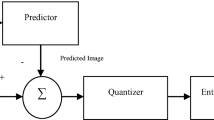Abstract
To address the low compression efficiency of lossless compression and the low image quality of general near-lossless compression, a novel near-lossless compression algorithm based on adaptive spatial prediction is proposed for medical sequence images for possible diagnostic use in this paper. The proposed method employs adaptive block size-based spatial prediction to predict blocks directly in the spatial domain and Lossless Hadamard Transform before quantization to improve the quality of reconstructed images. The block-based prediction breaks the pixel neighborhood constraint and takes full advantage of the local spatial correlations found in medical images. The adaptive block size guarantees a more rational division of images and the improved use of the local structure. The results indicate that the proposed algorithm can efficiently compress medical images and produces a better peak signal-to-noise ratio (PSNR) under the same pre-defined distortion than other near-lossless methods.









Similar content being viewed by others
References
Placidi G: Adaptive compression algorithm from projections: Application on medical greyscale images. Comput Biol Med 39(11):993–999, 2009
Fidler A, Skaleric U, Likar B: The impact of image information on compressibility and degradation in medical image compression. Med Phys 33(8):2832–2838, 2006
Chen K, Ramabadran TV: Near-lossless compression of medical images through entropy-coded DPCM. IEEE Trans Med Imaging 13(3):538–548, 1994
Singh S, Kumar V, Verma HK: Adaptive threshold-based block classification in medical image compression for teleradiology. Comput Biol Med 37(6):811–819, 2007
Lee JO, Jang SK, Chen QS, et al: An efficient frame rate up-conversion method for mobile phone with projection functionality. IEEE Trans Consum Electron 53(4):1615–1621, 2007
Muhit AA, Pickering MR, Frater MR, et al: Video coding using fast geometry-adaptive partitioning and an elastic motion model. J Vis Commun Image Represent 23(1):31–41, 2012
Zhao XO, He ZH: Lossless image compression using super-spatial structure prediction. IEEE Signal Process Lett 17(4):383–386, 2010
Hartenstein H, Herz R, Saupe D: A comparative study of L1 distortion limited image compression algorithms. Proc Picture Coding Symp 51:55, 1997
Aràndiga F, Mulet P, Renau V: Lossless and near-lossless image compression based on multiresolution analysis. J Comput Appl Math 242:70–81, 2013
Caldelli R, Filippini F, Barni M: Joint near-lossless compression and watermarking of still images for authentication and tamper localization. Signal Process-Image Commun 21(10):890–903, 2006
ISO/IEC 14495–1: Information Technology-Lossless and Near-lossless Compression of Continuous Tone Still Images: Baseline. Dec. 1999. JPEG-LS source code available at: http://www.stat.columbia.edu/%7Ejakulin/jpeg-ls/mirror.htm, 1999
Miguel A, Riskin E, Ladner R, et al: Near-lossless and lossy compression of imaging spectrometer data: comparison of information extraction performance. SIViP 6(4):597–611, 2012
Yea S, Pearlman W: A wavelet-based two-stage near-lossless coder. IEEE Trans Image Process 15(11):3488–3500, 2006
Koga T: Motion-compensated interframe coding for video conferencing. Proc NTC’81. 1981: C9. 6.1-9.6.5
Ghanbari M: The cross-search algorithm for motion estimation. IEEE Trans Commun 38(7):950–953, 1990
Moshnyaga VG: A new computationally adaptive formulation of block-matching motion estimation. IEEE Trans Circuits Syst Video Technol 11(1):118–124, 2001
Lin Y, Zhuang Q, Yang R: Image reconstruction of dynamic MRI based on adaptive motion estimation. IEEE Int Conf ICARCV 1586–1590, 2012
Chen J, Zhou J, Yu S, et al: A Very Low Bit Rate Video Coding Combined with Fast Adaptive Block Size Motion Estimation and Nonuniform Scalar Quantization Multiwavelet Transform. Multimed Tools Appl 26(1):123–144, 2005
Wei ST, Tien CW, Liu BD, et al: Adaptive truncation algorithm for Hadamard-transformed H. 264/AVC lossless video coding. IEEE Trans Circuits Syst Video Technol 21(5):538–549, 2011
Lim C, Kim G, Yoon C, et al: Context modeling based lossless compression of radio-frequency data for software-based ultrasound beamforming. Biomed Signal Process 8(6):682–687, 2013
Sun J, Ren G, Wu Q: Image compression algorithm based on adaptive exp-Golomb coding. Opt Precis Eng 21(11):2973–2979, 2013
Nelson M, Gailly J L: The data compression book. New York: M&T Books, 1996, Chapter 6, order 3 arithmetic coding
Computer Vision Group [online]: Available at: http://decsai.ugr.es/cvg/index2.php. Accessed Aug 2011
Wu X, Memon N: CALIC—a context based adaptive lossless image codec. Proc ICASSP. 1996, 4: 1890–1893. CALIC source code available at: http://compression.graphicon.ru/download/sources/i_glless/codec.zip
ISO/IEC JTC 1/SC 29/WG 1, ISO/IEC FCD 15444–1, Information Technology – JPEG 2000 Image Coding System, 2000. JPEG2000 source code available at: http://www.kakadusoftware.com/
Said A, Pearlman W: A new, fast, and efficient image codec based on set partitioning in hierarchical trees. IEEE Trans Circuits Syst Video Technol 6(3):243–250, 1996
Acknowledgments
This work was supported by the National Natural Science Foundation of China (grant nos. 61574102, 61404094, and 61204096), the Fundamental Research Fund for the Central Universities, Wuhan University (grant no 2042014kf0238), and the Hubei Province Science & Technology Pillar Program (grant no. 2015CFB536).
Author information
Authors and Affiliations
Corresponding author
Rights and permissions
About this article
Cite this article
Song, X., Huang, Q., Chang, S. et al. Novel Near-Lossless Compression Algorithm for Medical Sequence Images with Adaptive Block-Based Spatial Prediction. J Digit Imaging 29, 706–715 (2016). https://doi.org/10.1007/s10278-016-9892-y
Published:
Issue Date:
DOI: https://doi.org/10.1007/s10278-016-9892-y




